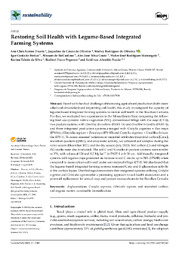Restoring soil health with legume-based integrated farming systems.
Restoring soil health with legume-based integrated farming systems.
Autoria: DUARTE, A. C. S.; OLIVEIRA, J. de C. de; OLIVEIRA, W. R. de; FREITAS, I. C. de; CARDOSO, A. S.; COUTO, A. J. S.; MATRANGOLO, W. J. R.; SILVA, K. T. da; PEGORARO, R. F.; FRAZÃO, L. A.
Resumo: Faced with the dual challenge of increasing agricultural production (both intensified and diversified) and improving soil health, this study investigated the capacity of legume-based integrated farming systems to restore soil health in the Brazilian Cerrado. For that, we evaluated two experiments in the Minas Gerais State comparing the following land use systems: native vegetation (NV), conventional tillage with Zea mays (CT-8), two pasture systems with Urochloa decumbens (PAST-13) and Urochloa brizantha (PAST-1), and three integrated production systems arranged with Cratylia argentea + Zea mays (IPS-8A), Gliricidia sepium + Zea mays (IPS-8B) and Cratylia argentea + Urochloa brizantha (IPS-1). To assess seasonal variations in microbial attributes (microbial carbon [Cmic], microbial quotient (qMIC), and enzymatic activity, we collected soil samples during the rainy season (December 2021) and the dry season (July 2022). Soil carbon (C) and nitrogen (N) stocks were also evaluated. The soil C and N stocks in pasture systems were similar to VN, with values of 120 and 8.2 Mg ha?1 in PAST-1 at 0–30 cm. Additionally, integrated systems with legume crops promoted an increase in soil C stocks up to 24% (IPS-8B) when compared to monoculture cultivated under conventional tillage (CT-8). We also found that the legume-based integrated farming systems increased Cmic and ?-glucosidase activity at the surface layers. Our findings demonstrate that integrated systems utilizing Cratylia argentea and Gliricidia sepium offer a promising approach to soil health restoration and a potential replacement for annual crop and pasture monocultures in the Brazilian Cerrado.
Ano de publicação: 2025
Tipo de publicação: Artigo de periódico
Unidade: Embrapa Milho e Sorgo
Palavras-chave: Carbono, Cratylia argentea, Leguminosa Forrageira, Matéria Orgânica, Microbiologia do Solo
Observações
1 - Por padrão são exibidas publicações dos últimos 20 anos. Para encontrar publicações mais antigas, configure o filtro ano de publicação, colocando o ano a partir do qual você deseja encontrar publicações. O filtro está na coluna da esquerda na busca acima.
2 - Para ler algumas publicações da Embrapa (apenas as que estão em formato ePub), é necessário ter, no celular ou computador, um desses softwares gratuitos. Sistemas Android: Google Play Livros; IOS: iBooks; Windows e Linux: software Calibre.
Acesse outras publicações
Acesse a Base de Dados da Pesquisa Agropecuária (BDPA) para consultar o acervo completo das bibliotecas da Embrapa.

